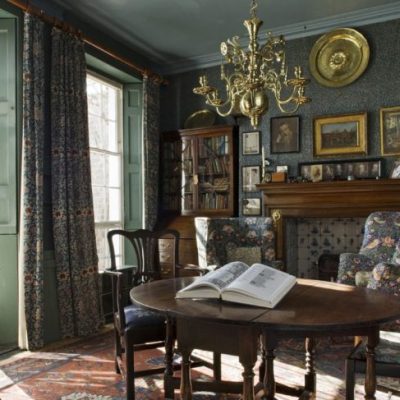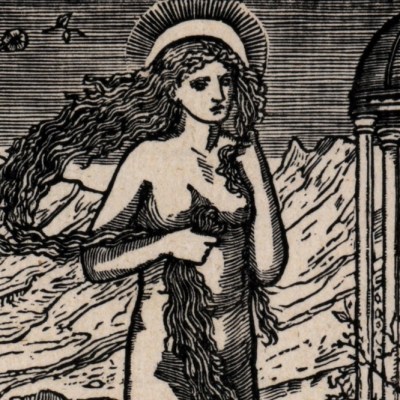In 2009, the social historian Tamsin Wimhurst was working for the Museum of Cambridge on a project about the home. Someone suggested that she visit a Mrs Elsie Palmer, who lived locally. ‘We weren’t looking for the extraordinary, we were just looking for the ordinary,’ Wimhurst says. ‘But we walked into a space that was so very far from normal.’ Behind the door of Palmer’s modest Victorian terraced house lay an Arts and Crafts dreamworld of hand-painted wallpapers and woodwork, carved furniture and stained glass. ‘I looked at these walls and thought, why are they here? What’s the history behind them?’
Elsie Palmer told Wimhurst about the life of her grandfather, David Parr: a craftsman employed by the interiors firm F.R. Leach & Sons, which worked with designers including William Morris. Parr bought the house on Gwydir Street in 1886 and spent the next 40 years decorating it in the style of the stately homes he painted for the company. ‘He was a man from a very poor background who was creating a sort of earthly Paradise for his family,’ Wimhurst says.
The Drawing Room at the David Parr House. Photo: Lucinda Douglas Menzies; courtesy the David Parr House

Palmer lived in Parr’s creation from his death in 1927 until 2012 and changed almost nothing. When she eventually moved into a residential home, the situation became ‘very critical’, Wimhurst says. ‘I thought, the place is going to be bought, and someone’s just going to paint over all these walls.’ She informed her ‘incredibly understanding’ husband that they were going to buy a property and, in 2014, the couple purchased what is now known as the David Parr House. ‘I thought it would be a bit of a hobby, that the odd person might want to see it,’ she says.
They began the process of conservation, stabilising damp walls, fixing damage and ensuring that conserved objects were returned to their previous positions (including Mrs Palmer’s miniature Christmas tree, still bearing its supermarket label). Press coverage followed – including from Apollo – and public interest rapidly became overwhelming. Realising they had to do the thing properly, the couple created a charity to formalise the running of the house.
That decision to buy Parr’s house – ‘a sort of impulse’ – was the first in a series of efforts to help preserve unusual homes. In 2019, Wimhurst was contacted by curator Sasha Galitzine, who wanted to learn how a small house-museum might be made financially viable, its fabric protected while still welcoming the public. Galitzine was part of a campaign to save Gerry’s Pompeii: a surreal mishmash of sculptures, pictures, topiary and sparkling decor hidden in a one-bed housing association flat and garden in Notting Hill, put together by Gerry Dalton.
Sculptures by Gerry Dalton in his home in London in 2019. Photo: Jill Mead; courtesy Gerry’s Pompeii
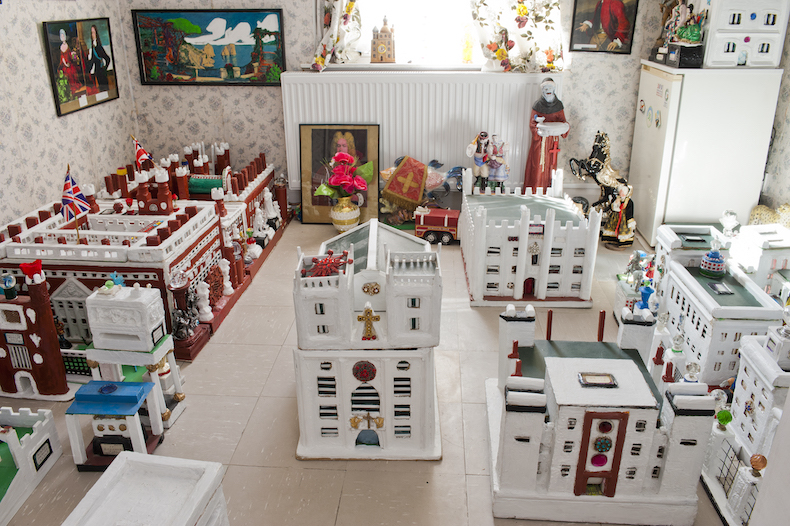
Much like Parr, Dalton spent decades decorating his place; unlike Parr, Dalton was an autodidact. He taught himself to sculpt with cement, favouring eminent people as his subjects (British royals were a particular favourite). ‘Visiting Gerry’s Pompeii just brought a smile to my face,’ Wimhurst says. She offered advice and financial support, but after a fundraising drive failed to reach its target of £550,000, the housing association took back ownership in 2020. Today, all that remains of his original vision in situ is a series of 50 sculptures beside a mural in the narrow strip between the Grand Union canal and his garden wall (Dalton scaled a ladder to reach the space).
Galitzine is now the director of a charity based on the ‘values of the house’, which protects what’s left of Dalton’s work and organises what it calls ‘happenings and antics’, most recently an ‘Alternative Village Fete’. ‘Hopefully that will live on even if the space couldn’t be saved – which, can I say, breaks my heart,’ Wimhurst says.
Sculptures by Gerry Dalton lining the canal-side garden wall at Gerry’s Pompeii, London. Photo: Jill Mead; courtesy Gerry’s Pompeii
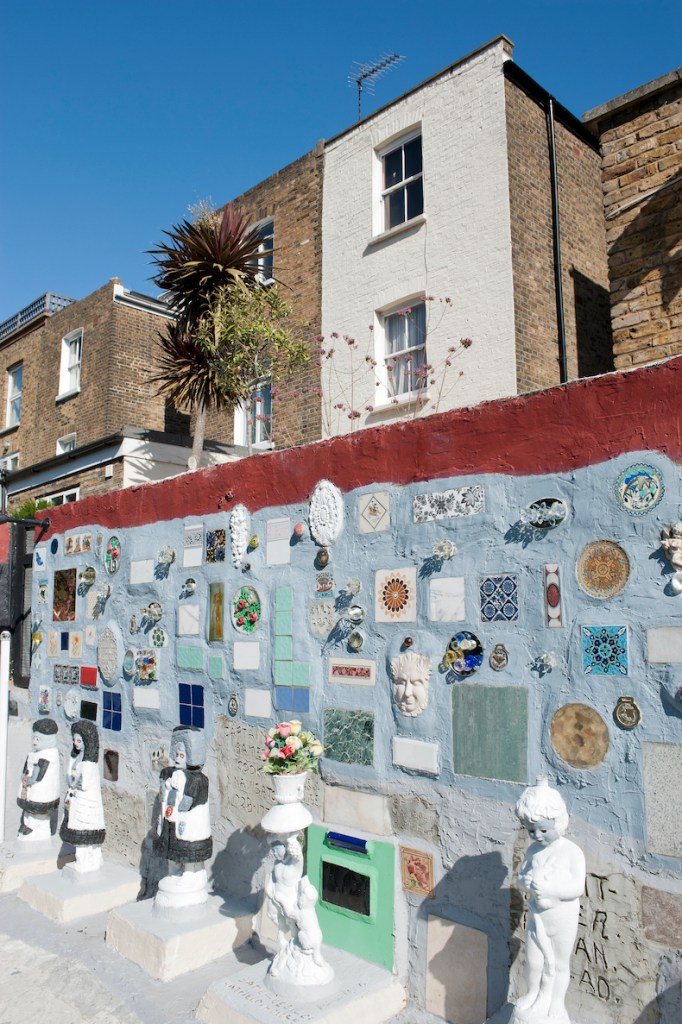
Gerry’s Pompeii isn’t the only site to have got away. Shortly after acquiring Parr’s house, Wimshurst discovered that his employers’ premises were still standing – but about to be pulled down for redevelopment. It would have cost £1m to buy what she calls its ‘important vernacular buildings’, and another £1m to turn them into a museum. With just a couple of months’ left before demolition, it was too much money to raise in such a short window of time. With help from a sympathetic developer, however, she was able to save some ‘really interesting’ material now on display in the visitor’s centre next door to the David Parr House. ‘I do accept that there has to be loss – you can’t save everything,’ Wimhurst says. ‘If I can step in for a few places, maybe that’s enough.’
On 1 March 2023, Wimhurst came across an article in the Guardian about a remarkable flat in Birkenhead, Wirral. Known as ‘Ron’s Place’, it was the creation of Ron Gittens, who, over 30 years, had secretly transformed his rented flat into a dizzying fantasia of outsider art. Murals on historic themes vie for attention with ancient Egyptian- and Greco-Roman-style sculptures – most notably, a fireplace in the form of a ferocious minotaur. The flat was due to be sold at auction that afternoon.
A minotaur’s-head fireplace by Ron Gittens at Ron’s Place, Birkenhead. Photo: courtesy Wirral Arts and Culture Community Land Trust

Wimhurst looked up the fundraising page of the group trying to save Ron’s Place and realised there was no way they would reach their target in time. She messaged that same morning, offering them the money. Bidding closed at £335,000 with the newly-formed Wirral Arts & Culture Community Land Trust the winning bidder, thanks to her last-minute donation.
This year, on the advice of Historic England, Gittens’ flat was granted Grade II-listed status – making it only the second outsider art environment to be thus protected. (The first is 575 Wandsworth Road, the wooden fretwork-encrusted home of the civil servant Khadambi Asalache, managed by the National Trust since 2010.) ‘We like to support those things that maybe don’t normally get supported. I understand why – they’re unknowns’, she tells me. Ron’s Place is now closed for essential maintenance, but a community-focused arts programme is in the works for its reopening. ‘I have every faith that something will happen,’ Wimhurst says. ‘I don’t mind too much what that will be.’
A lion’s-head fireplace and painted walls by Ron Gittens in Ron’s Place, Birkenhead. Photo: courtesy Wirral Arts and Culture Community Land Trust
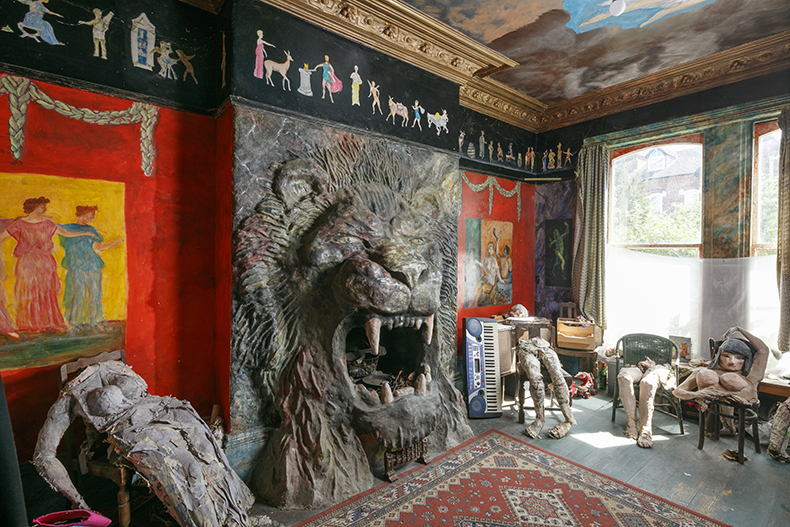
During their lifetimes, all three men kept their world-building private. It’s likely that only Parr’s family were privy to his interior designs; the full extent of both Gittens’ and Dalton’s work was discovered posthumously. Wimhurst imagines they might be ‘tickled pink’ to know their work had been preserved. ‘Wouldn’t you be, if you had done all that?’
There’s another rescue project in the pipeline, but Wimhurst doesn’t want to reveal more just yet. Whatever it is, it is bound to be intriguing and idiosyncratic. As Wimshurst says, ‘David Parr’s, Gerry’s Pompeii, Ron’s Place: they all have a narrative, they all have something to show us, to educate us, to experience – to just enjoy.’

